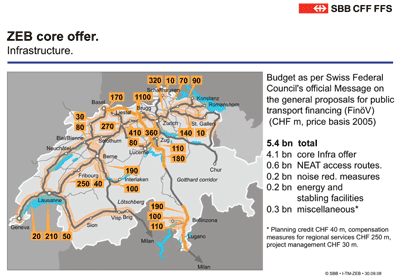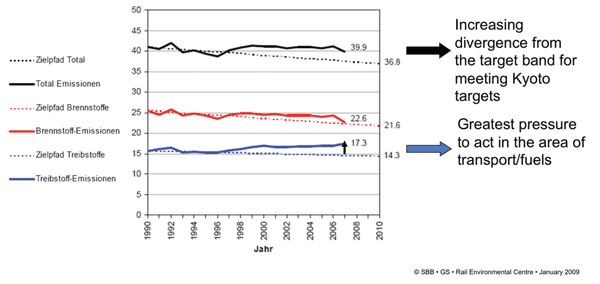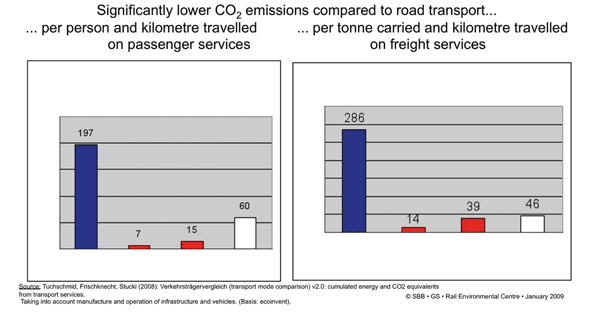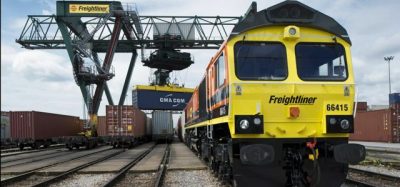The future development of Swiss rail infrastructure – ZEB
Posted: 21 July 2009 | | No comments yet
Charles Wyss of Gotthard Access and ZEB Program Portfolio and Markus Halder of Swiss Federal Railways SBB discuss the long-term demand and future mobility requirements of its customers in both the passenger and freight sectors.
Charles Wyss of Gotthard Access and ZEB Program Portfolio and Markus Halder of Swiss Federal Railways SBB discuss the long-term demand and future mobility requirements of its customers in both the passenger and freight sectors.
Before new rail projects are discussed at SBB Infrastructure, the division first establishes the long-term demand and future mobility requirements of its customers in both the passenger and freight sectors.
SBB’s planning philosophy
A defined offer concept – integrated with the rolling stock concept and the necessary adjustments to railway infrastructure – is considered as part of the so-called ‘planning triangle’ and applied to the whole network. In this conceptual phase, SBB evaluates the needs of railway companies in both the passenger and freight sectors, as well as those of cantonal representatives and other interested parties. As part of a timetable study, SBB’s experts calculate the feasibility and necessity of network infrastructure adjustments. The building and technical aspects of these then form the subject of a separate feasibility study, as well as a cost estimate. SBB then makes a final decision on how to implement the phases of any project based on business and economic criteria.
What is meant by the expression ‘Zukünftige Entwicklung Bahninfrastruktur’ (‘Rail Infrastructure Development Plan’ – ZEB)?
The forerunner of ZEB was phase 1 of Rail 2000, which was brought into service with the timetable change in December 2004. The Swiss Federal Office of Transport (FOT) and SBB then jointly began work on the ZEB programme, a second phase of development, again on a national level. ZEB completes the original idea of the first phase of Rail 2000 – the hub principle.
ZEB takes into account market potential and the major changes in traffic flows up to 2030. Numerous minor upgrades to the network are planned in order to achieve an optimum effect. The planning team has attempted to avoid larger, and therefore more expensive, expansions (such as completely new high-speed routes or tunnels) as far as possible, in light of its limited room for financial manoeuvre.
Passenger numbers are predicted to rise by just under 60% by 2030, although at peak times and in certain hotspots this increase could be as much as 100%. ZEB allows long-distance passenger and freight travel to grow at the same rate, benefiting Switzerland as a whole. The network is being expanded in the areas with the greatest market potential and where the least demands will be made on the public coffers, but also where there is the greatest benefit for the entire network. Upgrades are being concentrated on the east-west and north-south corridors. Specifically, the main measures are as follows:
- Speeding up the journey time between Geneva and St. Gallen (reduction of journey time by 30 minutes)
- Increasing the offer on the heavily used sections of the east-west corridor
- Optimising capacity on the approaches to the new transalpine rail routes (NEAT)
The benefits of ZEB for long-distance passenger services include:
- Better connections in the major towns and cities
- The expansion of our offer on the corridors with the greatest demand (especially at weekends and peak times)
The benefits of ZEB for freight services include:
- The expansion of capacity for the transfer of freight to rail on the approach routes to the new Gotthard and Ceneri tunnels (NEAT)
- Continuing the Swiss government policy of transferring traffic from road to rail
- Securing capacity for domestic freight services on the east-west corridor
Division of roles and cooperation between SBB, the federal government and the cantons
The party commissioning ZEB is the Swiss Confederation, represented by its Federal Office of Transport (FOT) as regulatory authority. The FOT prepares the content of the ZEB programme in light of current political circumstances and provides support for each phase, including involvement in the infrastructure measures defined by SBB as described earlier. At cantonal and municipal level, cooperation between the various parties takes place primarily at individual project level.
Funding
ZEB will be financed by the special FinöV public transport fund, which the federal government uses for financing major public transport projects. This is the same fund that has been tapped to finance Rail 2000, NEAT, the links to the European high-speed rail network and various noise reduction measures. The FinöV fund is fed by the heavy goods vehicle tax and contributions from value added and petroleum taxes. The ZEB package was passed by the Swiss parliament in spring 2009. It comprises infrastructure improvements to the tune of CHF 5.4 billion.
The SBB distinguishes between the following categories of expansion within ZEB:
- Speed increases
- Measures to increase the number of services through projects to ‘disentangle’ traffic flows and expand the network (flyovers, underpasses, additional tracks, etc,)
- Increasing the number of services by reducing train headways
- Power supply improvements
- Noise reduction measures
Implementation of ZEB
The ZEB programme is currently scheduled to be implemented by 2030, with work to be completed in various phases, such as the commissioning of the cross-city link in Zurich in 2013/15 or NEAT in 2017/19.
On a political level, the ZEB Act will come into force by the end of this year. This provides the formal basis for the financing of the project and thus a framework to ensure that ZEB is implemented on time and successfully. A number of project management processes are already underway with the goal of bringing the first new structures into service in time for the 2013 timetable, as well as others with longer term planning, project management and implementation timelines. SBB is due to launch the first building projects in mid-2011.
Public transport and climate change: the contribution of ZEB to reducing CO2 emissions in Switzerland
The emissions targets set out by the Kyoto protocol and the federal CO2 Law are central to Swiss policy on climate change. By signing the Kyoto agreement, Switzerland has committed itself to an 8% reduction in its greenhouse gas emissions by 2012, compared with 1990.
With the level of emissions from traffic constantly rising, this sector is now the biggest producer of greenhouse gases in Switzerland.
CO2 emissions caused by the burning of fossil fuels to provide energy or to power vehicles are to be reduced by 10% overall by 2010 (15% for energy supply, 8% for vehicles), compared with 1990 levels.
The comparison of the CO2 Law targets in Figure 2 with the actual data on emissions shows a clear rise in emissions from transport (fuels). The reduction of traffic-related CO2 emissions is therefore of great importance if the commitments made at Kyoto are to be upheld.
Advantages inherent in the rail system allow it to be more energy-efficient
A major benefit of the wheel/track system is its low rolling resistance. In addition, trains have a relatively low level of air resistance thanks to their linear composition. Electric traction also enables the optimum conversion of electrical energy into kinetic energy, and allows as much braking energy as possible to be returned to the grid. These factors make rail transport more energy-efficient than road transport. To carry one person 100km, SBB uses the end energy equivalent of one litre of petrol: to carry a tonne of freight the same distance takes on average just 0.7 litres of diesel3.
SBB produces the majority of the energy it requires to power its trains at its own power stations and those of its partners. In 2008, SBB sourced 74% of railway electricity from hydroelectric power; the rest came almost exclusively from nuclear power. Because the network is almost entirely electrified, almost all motive power required is electric, drawing on the environmentally sustainable services described above.
Significantly lower CO2 emissions compared with road transport
Rail’s high energy efficiency, allied to the fact that most railway electricity is produced climate-neutrally, means that rail produces far less CO2 per person and kilometre travelled. The same is true for each tonne of freight transported (see Figure 3).
SBB’s emissions from passenger and freight services are, on average, lower than those from the equivalent form of road transport by a factor of approximately 20. If fossil fuels such as coal, gas and oil are used to produce the electricity that powers trains (as is the case with the ICE in Germany, for example), the CO2 efficiency of rail is lower than at SBB, but still at least three times as high as the road equivalent.
Anyone interested can use the calculation tool at www.sbb.ch/ecopassenger to calculate the comparative carbon footprints of any journey by road against the same journey by rail.
The contribution of ZEB to reducing CO2 emissions
The ‘Nachhaltigkeitsindikatoren für Bahninfrastrukturprojekte’ (‘sustainability indicators for rail infrastructure projects’ – NIBA)5 process, designed by the Federal Office of Transport (FOT), is used to evaluate rail infrastructure projects in Switzerland. The FOT also used this process to evaluate SBB’s ‘ZEB offer’.
The result of the cost-benefit analysis shows that ZEB will generate a reduction in CO2 emissions worth CHF 18 million a year. The total economic benefit in terms of ecology is estimated at CHF 40 million a year. As well as greenhouse gas emissions, ZEB will reduce air pollutant and noise levels and soil surface sealing. The savings as a result of the reduction of road traffic are far greater than the additional strain to be placed on the rails.
The transfer of traffic from road to rail as set out in the ZEB offer would reduce CO2 emissions by over 160,000 tonnes a year. This is equivalent to the per capita annual emissions of 27,000 Swiss residents.
The reduced CO2 emissions made possible by ZEB represent an important contribution to the overall reduction of CO2 output in Switzerland. This is of particular significance bearing in mind the rising CO2 emissions from traffic – despite the national targets to lower them – and the rapidly growing pressure to take measures to reduce greenhouse gases.
Outlook
The management at SBB faces a number of challenges in implementing ZEB: with limited (project) staff resources, they must manage the additional traffic density generated by the programme, as well as coordinating building work on an already extremely heavily used network with the least possible effect on services – all this while taking appropriate account of the economic aspects of the programme. What is more, SBB must stay below the cost ceiling of CHF 5.4 billion set by parliament. This means searching for innovative, intelligent solutions, not only throughout the earlier implementation phase but also once ZEB is operational, in the form of cost-efficient operating and maintenance structures. The project is also likely to be influenced by the duration and intensity of the current economic downturn, the consequences of which are difficult to predict.
SBB is becoming a victim of its own success on the rail network: demand is rising far above the level predicted up to now, with passenger volumes on trains and in stations already difficult to manage at peak times – a situation that ZEB will not be able to rectify entirely. Severe bottlenecks are already evident in some urban areas and in services between the major towns and cities. The stability of the network is also increasingly becoming a central question: the ZEB expansions will relieve pressure on the network at certain points, but the long-term stability and sufficient capacity of the network will only be guaranteed with larger and more flexible investments. It is for this reason that the Swiss Federal Council laid the foundations for further network expansion in December 2008 by commissioning the FOT and SBB to draft a project for the next-but-one phase of the upgrade of the Swiss rail offer by 2010, with a budget of between CHF 12 and 21 billion, entitled ‘Rail 2030′.


Figure 1


Figure 2: Greenhouse gas emissions by cause, as per Kyoto protocol, for 2007 (1)


Figure 3: Pattern of CO2 emissions in Switzerland as per the CO2, Law (2)


Figure 4: Comparison of CO2 equivalents per passenger-kilometre/tonne-kilometre (4)
References
- Swiss Federal Office for the Environment (FOEN): ‘Emissions as per the CO2 Law and the Kyoto protocol’. Last updated: 15 April 2009.
- cf. section 1.
- By comparison: average Swiss car carrying 1.6 people: 5.6 litres of petrol per 100 passenger-kilometres; average Swiss truck: 6.4 litres of diesel per 100 tonne-kilometres.
- Tuchschmid, Frischknecht, Stucki (2008): Verkehrsträgervergleich (transport mode comparison) v2.0: cumulated energy and CO2 equivalents from transport services. Taking into account manufacture and operation of infrastructure and vehicles. (Basis: ecoinvent).
- Federal Office of Transport – NIBA: Nachhaltigkeitsindikatoren für Bahninfrastrukturprojekte, Berne/Zurich, 1 February 2006.
Issue
Related topics
Funding & Finance, Infrastructure Developments, Regulation & Legislation






